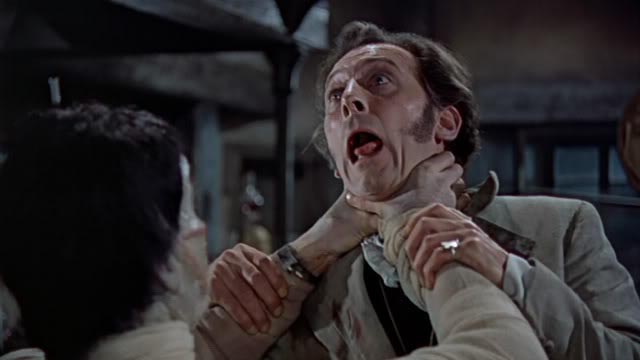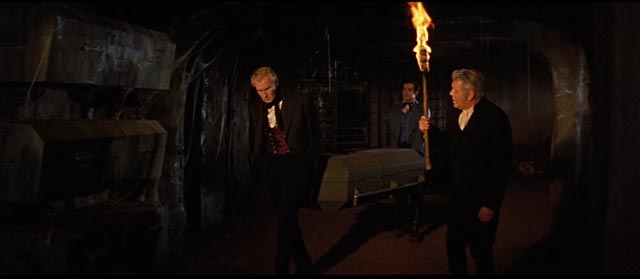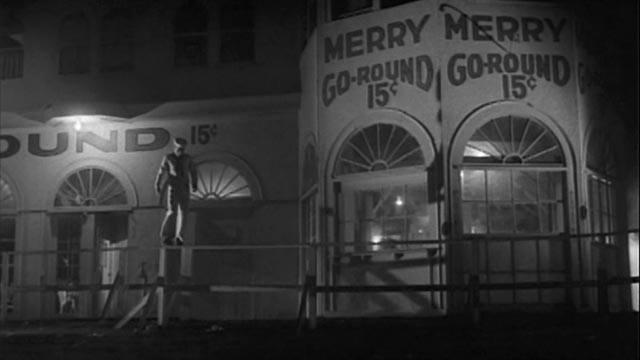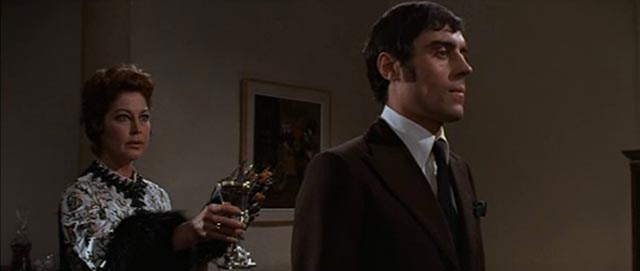Genre On Disk, part one
My genre viewing on disk over the past couple of months ranges from classics to crap, and I have to admit that I’ve enjoyed it all.

The Curse of Frankenstein (1957)
From England, I’ve obtained impressive Blu-rays of three key movies from the period when “modern” horror was born: Hammer’s first two colour Gothic features, The Curse of Frankenstein and Dracula (aka Horror of Dracula), both films served well by Lions Gate, and Roger Corman’s House of Usher (or Fall of the House of Usher), from Arrow. Not surprisingly, The Curse of Frankenstein (1957) is a bit coarse. Produced on a low budget and based on only the second script written by the then-29 year old Jimmy Sangster, it was attempting something new and, in a sense, feeling its way. Directed by Terence Fisher, it determinedly aimed for a sense of rather brutal physicality instead of poetry. The creature was a surgical horror, a patched together walking corpse rather than the soulful rejected child portrayed by Boris Karloff in 1931 or the educated, sensitive man shunned for his deformity in The Bride of Frankenstein in 1935. This was neither poetic fantasy nor wry satire but an attempt to break taboos by depicting graphic charnel horror, to be direct rather than coy about the physical reality of death.
Although there’s been a lot of on-line complaining about the restorations of both Hammer films, the Frankenstein disk represents a convincing film-look for a movie made at that time with those resources. Yes, it’s pretty grainy, but the colours are quite vibrant. The three-disk set includes two versions of this key film, one in the full open-matte Academy ratio, the other framed for 1.66:1. As with many non-anamorphic movies of the time, it was most likely intended to be shown with in-projector matting creating a wider image, so the 1.66:1 transfer is probably the correct one, but the full frame image, with more head and foot room, looks well-framed and is certainly watchable. The set includes a commentary, a documentary about the production, an engaging reminiscence by Peter Cushing’s long-time secretary … and Terence Fisher’s earlier black-and-white science fiction feature Four Sided Triangle (1953), one of two SF films he directed that year, two years before Hammer made its fateful commitment to fantasy/horror with Val Guest’s The Quatermass Xperiment. Four Sided Triangle is an interesting film, rooted in character, with its technological innovation (a machine which can duplicate anything perfectly) used as a device to expand on the emotional conflicts of the characters. It serves as an interesting precursor to the studio’s more influential genre productions, the best of which retained that formative emphasis on character.

Dracula (aka Horror of Dracula) (1958)
As important as The Curse of Frankenstein is historically, initiating a new, more graphic approach to horror, it remains fairly crude in many ways. Writer Jimmy Sangster took a big leap with his follow-up, an adaptation of Bram Stoker’s Dracula (1958), which wrestles that unwieldy novel into a tight, well-structured ninety minutes while making explicit the sexual undertones hinted at in the Lugosi version of 1931 and somewhat more openly in the concurrent Spanish version directed by George Melford, establishing what has remained the central sexual metaphor of the vampire genre that’s still with us. Again on-line commenters have complained about the colour values of this restoration (done chiefly by the BFI in 2007), asserting that it’s “too cold” with an overlay of blue. Actually, the film has rich, saturated colours, cool in night scenes perhaps, but by no means appearing overly manipulated. More importantly, in the 2012 Hammer restoration which uses the BFI’s version as its base, fragments taken from a severely damaged Japanese print reinstate several moments which were edited out before the original British release – in particular a more charged bit of neck-biting between Dracula and Mina and several more graphic glimpses of the Count’s climactic disintegration. Although all the shots from this last could not be included in the restoration because the soundtrack was unavailable, the entire sequence is present in one of the supplements – the four final reels which are all that remain of the Japanese print. It’s fascinating to compare the wretchedly deteriorated state of these reels with what the restorers have managed to accomplish, both as an illustration of what is now technically possible and as a reminder of what’s happening to so many films which are decaying for want of the money and the will to save them. The three-disk set contains two versions – the BFI restoration of the British cut and the 2012 version with the added material; a commentary; and several featurettes on the production, the restoration and, from Christopher Frayling, the cultural meanings of the famous vampire count.

House of Usher (aka Fall of the House of Usher)
(Roger Corman, 1960)
Less historically significant perhaps because it was itself heavily influenced by the Hammer films, Roger Corman’s House of Usher (or Fall of the House of Usher, 1960) served to raise the image of American horror from the cheesy, teen B-movies of the ’50s. It gave the genre an air of class (adapted from a recognizable literary classic), infused it with vibrant colour in well-composed widescreen images, and – through the richly ripe performance of Vincent Price as the mad Roderick Usher – gave the horror a theatrical tone which irrevocably separated it from teenage werewolves and radioactive mutants. Richard Matheson’s script treats the story with respect and, like Hammer’s Dracula, makes explicit the sexual undertones. In fact, more than the early Hammer films, Usher is suffused with an atmosphere of decadent perversity; the core of the horror lies in Roderick’s unhealthy obsession with his sister Madeline, a possessiveness which prefers to drive her insane and ultimately destroy her rather than see her leave him for another man. The film’s strengths are Corman’s visual imagination (ably supported by Floyd Crosby’s widescreen cinematography) and Price’s performance; while Myrna Fahey does quite well as the increasingly mad Madeline, Mark Damon as hero Philip Winthrop and Harry Ellerbe as family retainer Bristol unfortunately seem stuck in an earlier, cheesier version of the story. Like the Hammer disks, House of Usher has some informative extras, including a commentary by Corman (ported over from an earlier DVD), chats from director Joe Dante and critic Jonathan Rigby (which overlap somewhat), an archival interview with Price, and an odd, rather vague visual essay by David Cairns whose writing on his Shadowplay blog tends to be clearer than his presentation here.
It seems strange now that these movies were deemed offensive when first released. With what we’re accustomed to seeing at the local multiplex today, it’s amusing that the productions of Hammer and American-International Pictures were seen as an affront to good taste. But to some degree these movies were instrumental in fundamentally changing those ideas of good taste and represent one factor in the shattering of ’50s conservatism which led to the cultural and political upheavals of the ’60s.
But none of these richly colourful movies have the sense of style which was so strong in the best of the ’30s cycle of horror; Ulmer’s The Black Cat (1934), Freund’s Mad Love (1935), Browning’s The Devil-Doll (1936) and so many others were all heavily influenced by German Expressionism, which was still a very recent style. By the time Fisher and Corman approached the genre, classical Hollywood form had become the norm, a style which strove for invisibility, hiding its technical practices in order to foreground character and narrative. The horror in these later films is not embedded in their visual texture, but rather resides in the narrative content, the ideas of vampirism, the making of monsters, madness. Despite the lush photography, this is a kind of prosaic horror, domesticated, perhaps more entertaining but less disturbing.

Night Tide (Curtis Harrington, 1961)
While the Hammer and Corman films enthusiastically pushed towards extremes of blood, graphic mutilation and deformity with which the mainstream had flirted coyly over the years but almost always shied away from, Curtis Harrington’s Night Tide (1961), made in the same period, came from a different direction, with different intentions, visually harking back to Expressionism. Harrington was an experimental filmmaker with strong connections to Kenneth Anger, and that milieu inflects this, his first feature. The iconography of the naive young sailor in his tight-fitting uniform is familiar from Anger’s homoerotic films, and the theme of the fatal feminine which underlies Night Tide, the lethal threat of heterosexual attraction, has been seen many times in the underground films of the gay subculture of the mid-century.
But what genre does Night Tide belong to, or is it actually a genre film at all? Although I can no longer remember where I first read about this film back in the ’70s, possibly in Cinefantastique, I always had the impression that it was horror, specifically harking back to the work of Val Lewton in its suggestive ambiguity (there are direct references to Cat People in Mora’s belief that she belongs to an ancient supernatural race and in the strange, dark woman who turns up several times to speak to her in an unknown language). Night Tide also shares a dreamlike mood with Carnival of Souls (1962), another small black-and-white masterpiece made on the cinematic fringes in which suggestions of the supernatural destabilize the protagonist’s prosaic world.
But despite this threatening, dreamlike mood, the film could also be attributed to a sub-genre of fantasy, often more lighthearted or even comedic, involving hapless men being enchanted by sea creatures who appear as women – Ken Annakin’s Miranda (1948), Ron Howard’s Splash (1984), Neil Jordan’s Ondine (2009), M. Night Shyamalan’s Lady in the Water (2006) and John Sayles’ exquisite Secret of Roan Inish (1994). Or is it part of another sub-genre, again rooted in myth, which focuses on female monsters who lure men to untimely deaths – Fisher’s The Gorgon (1964) and Roddy McDowall’s Tam Lin (1970)?
In Night Tide a young sailor on leave sees a woman sitting alone in a small waterside jazz club and tries to strike up a conversation; but she brushes him off, then rushes out of the club when a strange woman says something ominous to her in a foreign language. The sailor follows her out and eventually exacts a promise to let him see her again the next day. So begins a tentative romance over which some unspoken shadow falls. The woman works at a cheap sideshow on the pier where she appears as a mermaid in a tank; the older man, a retired sea captain, who sells the tickets hints that the sailor should not get involved; the daughter of the man who runs the carousel on the pier tells him that in the past couple of years, two men who did become involved with the woman ended up dead, drowned at sea.
Like Irena in Cat People, who believed she belonged to a race which could transform into big cats when overcome by jealousy, Mora (Linda Lawson) believes she’s descended from an ancient race, the sirens who lured sailors to their death on the rocks around Greek islands. Like Oliver Reed in Cat People, young Johnny Drake (Dennis Hopper) is attracted not so much despite the potential danger as because of it, driven by a desire to save the woman from what he sees as a delusion. Harrington’s script is not quite as well-wrought as DeWitt Bodeen’s for the Lewton film, offering a mundane non-supernatural explanation for the film’s events which undercuts the eerie ambiguity maintained through much of the story. Its final hints that perhaps there was some supernatural element after all are not enough to call into question the explanation and seem merely a clumsy attempt to have it both ways.
But despite this minor weakness, Harrington[1] gives Night Tide an almost palpable sense of magic which envelopes the genuinely touching, tentative romantic feelings of the shy sailor and the lonely woman.

Tam Lin (aka The Ballad of Tam Lin, aka The Devil’s Widow) (Roddy McDowall, 1970)
There’s nothing shy about Michaela Cazaret, the woman at the centre of Tam Lin (aka The Ballad of Tam Lin, aka The Devil’s Widow, 1970), played by the larger-than-life Ava Gardner. Fabulously wealthy, she uses her money to surround herself with a collection of young, sexually active people (the ’60s love generation grown a bit more cynical and materialistic). The price these acolytes pay for the privilege of being supported by Michaela is occasionally suffering her outbursts of contemptuous anger. But the price for her young lovers is reputedly more severe. When her current boy toy Tom Lynn (a very young Ian McShane) falls for a local village girl (Stephanie Beacham) he finds this small hermetic society in which he’s been so comfortable turning against him.
The script by William Spier (long-time producer-director of the classic Suspense radio show in the ’40s) draws on the Scottish legend of Tam Lin, about a young man who gets involved with the fairy queen, falls for another, and is hunted to his death by the wrathful queen. Although the film has subtle hints indicating that Michaela is far older than she appears, that in effect she devours the youth of her lovers, the horror of what befalls Tom is more of a social catastrophe, the loss of a privileged position. He is humiliated and eventually “hunted” by Michaela’s tribe who are venting the jealousy and resentment they’ve had towards him for the particular favour in which he’s been held for a while.
Roddy McDowall’s sole directing effort, Tam Lin was poorly received, mutilated in various ways by distributors, and disappeared from view very quickly, leaving behind a reputation which was, to say the least, unflattering. Turning up now in a very nice Blu-ray edition from Olive Films, it turns out to be a fascinating glimpse of its time, a rather sour depiction of the cult of youth which grew out of the turbulent ’60s, and a work which maintains a careful balance between its hints of otherworldly forces and a decadent social reality. Like Night Tide, its connection to the idea of genre lies in its suggestion of mythic elements of the pre-modern era impinging on our own mundane time, hints of magic threatening to upturn an unmagical world where materialism has supplanted the immaterial, the spiritual. In this sense, it has ties back to the horror genre through Robin Hardy’s The Wicker Man, made just three years later (and Robin Redbreast, a BBC Play For Today broadcast in 1970, which also deals with ancient pagan rites lingering on in the English countryside).
________________________________________________________________
(1.) Harrington went on from this slightly esoteric film to a reasonably successful commercial career in genre filmmaking, but his movies often retain a slightly skewed perspective which makes them seem odd rather than formulaic, not entirely delivering the expected experience their genre elements seem to promise. Ruby mixes gangsters with possession and telekinesis, its exploitation links to Carrie reinforced by the presence of Piper Laurie in the lead. What’s the Matter With Helen? and Whoever Slew Auntie Roo? rise out of the “hag horror” genre which sprang up in the wake of Robert Aldrich’s Whatever Happened to Baby Jane?, but Auntie Roo in particular has a distinctive tone of its own rooted in its skewed retelling of Hansel and Gretel. Before those, however, working for Roger Corman and American International, he did a couple of those strange mid-’60s patch jobs which cannibalized East European SF and fantasy films for their effects sequences and created new stories around them; I’ve just seen the MGM Limited Edition DVD release of Queen of Blood (1966), which does a fair job of injecting its small cast and minimal sets into wide shots from the Soviet movie Mechte Navstrechu, while telling the story of a blood-drinking alien woman killing a space crew one by one. But apart from these and the more notable Games and The Killing Kind, much of his work consisted of TV movies which milked already tired genre tropes – Killer Bees, The Cat Creature, How Awful About Allan, The Dead Don’t Die, and let’s not forget Devil Dog: The Hound of Hell in which Satan returns to Earth as a suburban family pet. (return)
Comments